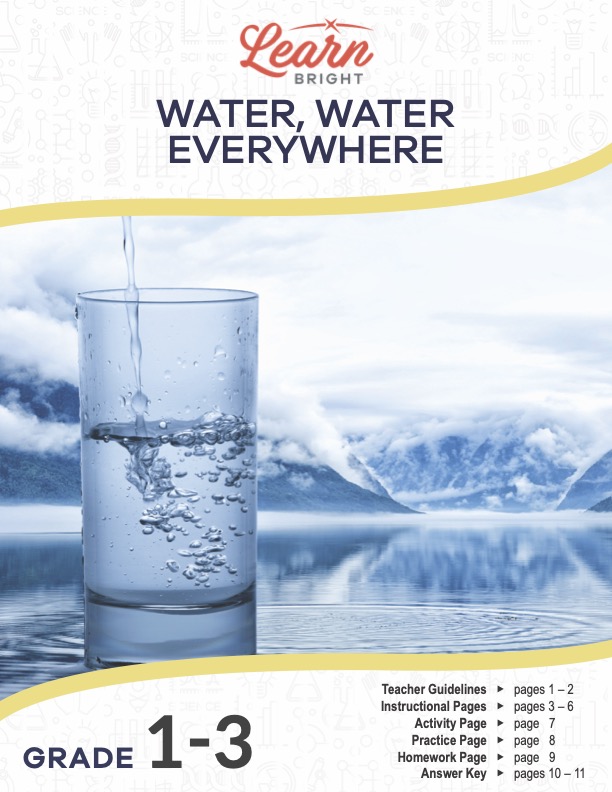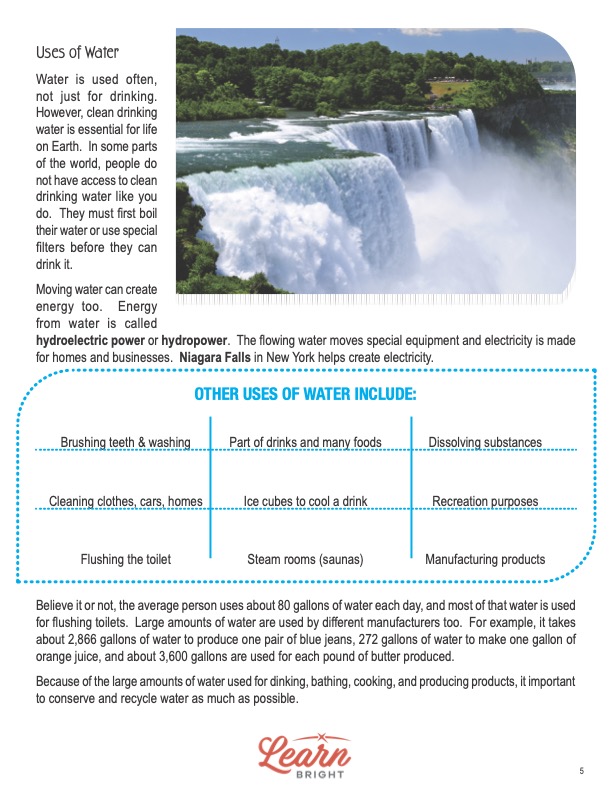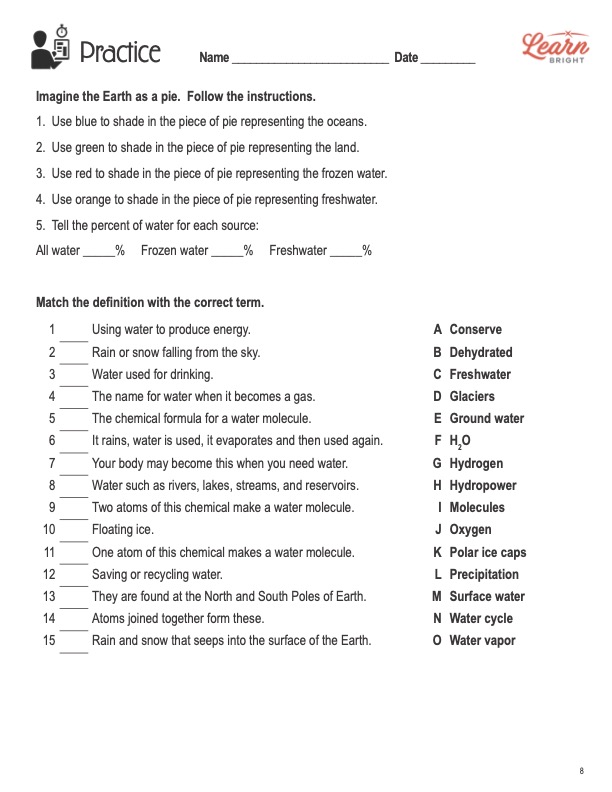Description
What our Water, Water Everywhere lesson plan includes
Lesson Objectives and Overview: Water, Water Everywhere teaches students about H2O and why it is crucial to life. Students will learn where to find it and discover the many uses for it. By the end of the lesson, they should be able to explain what it is and why it’s important. This lesson is for students in 1st grade, 2nd grade, and 3rd grade.
Classroom Procedure
Every lesson plan provides you with a classroom procedure page that outlines a step-by-step guide to follow. You do not have to follow the guide exactly. The guide helps you organize the lesson and details when to hand out worksheets. It also lists information in the yellow box that you might find useful. You will find the lesson objectives, state standards, and number of class sessions the lesson should take to complete in this area. In addition, it describes the supplies you will need as well as what and how you need to prepare beforehand.
Options for Lesson
There are several suggestions in the “Options for Lesson” section of the classroom procedure page that you could incorporate into the lesson plan if you wish. One suggestion is to have students keep a water journal for a full school day. Another idea is to invite a representative from a water company to speak with the class and answer their questions. You could also demonstrate how water melts, boils, and freezes. One final option is to bring a large map of the world and have students identify various water sources on the map.
Teacher Notes
The teacher notes page provides an extra paragraph of information about the lesson. It suggests teaching this lesson in conjunction with one on the water cycle. It also recommends creating simple experiments for students to perform that relate to water. You can use the blank lines on this page to write down any other thoughts you have as you prepare.
WATER, WATER EVERYWHERE LESSON PLAN CONTENT PAGES
What Is Water?
The Water, Water Everywhere lesson plan has four pages of content. It begins by describing several uses and functions of water. People use water every day. They drink it, wash with it, cool off with it, and cook with it. They can sprinkle it on plants to help them grow, put out fires, create energy, and much more. Without this substance, life on Earth would not even exist.
Students will then learn the recipe for how to create water. Two atoms of hydrogen and one atom of oxygen combine into a single molecule: H2O. A molecule is a group of atoms that make up a particular substance. Even though both hydrogen and oxygen are gases separately, they can create a liquid when combined with each other. In fact, water in any state—gas, solid, or liquid—is still comprised of molecules of H2O.
When water is in a liquid state, we simply call it water. In its liquid form, we can drink it, swim in it, or use it in a shower or bathtub. When it becomes a solid after freezing, it turns to ice. The temperature at which water freezes is 32°F. When water boils or reaches above 212°F, it transforms into its gaseous state, which we call water vapor. The bond between the hydrogen and oxygen atoms is so strong that it will remain together for millions and even billions of years. That is why H2O is the most common substance on Earth.
Sources
The next page describes some of the places where people can find water. Scientists believe the amount of water on the Earth today is the same amount that existed during the time of the dinosaurs. The water cycle is a continuous process where water falls as rain or snow and eventually evaporates back into the atmosphere. Because of this cycle, it is possible that the water we drink today was once used by a dinosaur!
Water covers about 70% of the Earth’s surface, and 97% of it is from the oceans. Another 2.4% is frozen in glaciers or in the polar ice caps near the North and South Poles, so we can’t drink it even though it’s fresh water. Ocean water is not safe to drink because it is salt water rather than fresh water. Salt water has to go through a special treatment process to remove the salt and make it drinkable.
The remaining 0.6% is the H2O that we can safely drink from freshwater sources. These sources include lakes, rivers, streams, creeks, and reservoirs. All of these fall into the category of surface water. Another source is ground water, which include the precipitation, like rain or snow, that seeps into the soil until it reaches rock material and settles in the spaces between rock particles. Eventually, though, it drains into the other freshwater sources.
Just as 70% of the Earth is water, the human body is also 70% water. (Yet there are some living organisms that are nearly 95% water!) Students will learn that playing sports or running around a lot causes them to sweat, which is how water leaves the body and evaporates into the air as a gas. As a result, their bodies feel dehydrated and they feel thirsty. When this happens, they need to replace the water they lost through sweating. Otherwise, they could get dizzy or sleep, suffer from a headache, or pass out.
Uses of and Conservation of H2O
Apart from being a primary and essential source for hydration, there are quite a few other uses for water. One is energy. Moving water can actually create energy through a process called hydroelectric power or hydropower. Flowing water moves special equipment and generates electricity for homes and businesses. In fact, Niagara Falls in New York actually helps create electricity.
Other uses include brushing teeth and showering, cooking, dissolving substances, steam rooms or saunas, and cleaning various objects like clothes or cars. The average person uses about 80 gallons of water each day, most of which is from flushing the toilet. Many manufacturers also use large amounts of water. For instance, it takes around 2,866 gallons of water to produce one pair of blue jeans, 272 gallons to make a gallon of orange juice, and 3,600 gallons to make a single pound of butter. Because we use so much water for all these things, it is important to conserve and recycle it as much as possible.
The lesson provides students with several ideas for how to conserve or save water. When they brush their teeth, they can turn off the water while they brush and turn it on just to rinse. It is unnecessary for the faucet to continue running when they aren’t using the water coming out. Similarly, taking shorter showers can greatly reduce the amount of water they use per day.
The lesson lists 10 other suggestions for ways students can conserve or recycle water, such as washing a full load of clothes or dishes rather than many small loads. They could install low-flow shower heads, take five-minute showers, and not take baths. They could also reduce the water amount that toilets use when they flush. And they could save rainwater in drums and use it to water their gardens or plants.
WATER, WATER EVERYWHERE LESSON PLAN WORKSHEETS
The Water, Water Everywhere lesson plan includes three worksheets: an activity worksheet, a practice worksheet, and a homework assignment. Each of these handouts will help reinforce students’ comprehension of the lesson content in different ways. Use the guide on the classroom procedure page to determine when to distribute each worksheet to the students.
JOURNAL ACTIVITY WORKSHEET
Students will work with a partner for the activity. However, you may have them work alone or in groups if you prefer. Students will first discuss a typical day with their partner. They should try to figure out when, why, and for what purposes they use water every day. Next, they will fill out the chart on the worksheet by following the prompts on the left.
EARTH AS A PIE PRACTICE WORKSHEET
The practice worksheet has two sections. For the first section, students will follow the instructions to create the Earth as a pie. Each slice will represent a different part of Earth, such as oceans, land, and fresh water. The next section requires students to match definitions to the correct terms from the word bank. There are 15 total statements and terms for them to match.
WATER, WATER EVERYWHERE HOMEWORK ASSIGNMENT
For the homework, students will first mark statements as true (T) or false (F). There are 10 statements total in this section. Next, students will indicate whether certain actions are a use for H2O or a way to conserve it. There are 14 actions in this section. Finally, students will draw pictures showing this critical substance as a liquid, a gas, and a solid.
Worksheet Answer Keys
The final pages of the lesson plan are answer keys for the practice and homework worksheets. These pages highlight or provide the correct answers in red. There should be no variation between students’ responses and the correct answers except for on the final section of the homework assignment. You can use your judgment to determine if students’ drawings accurately represent water in its three states. If you choose to administer the lesson pages to your students via PDF, you will need to save a new file that omits these pages. Otherwise, you can simply print out the applicable pages and keep these as reference for yourself when grading assignments.










